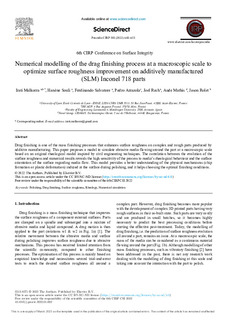Título
Numerical modelling of the drag finishing process at a macroscopic scale to optimize surface roughness improvement on additively manufactured (SLM) Inconel 718 partsAutor-a
Autor-a (de otra institución)
Fecha de publicación
2022Otras instituciones
Université de LyonIRT M2P
Naval Group CESMAN
Versión
Version publicadaTipo de documento
Contribución a congresoContribución a congresoIdioma
InglésDerechos
© 2022 The Authors. Published by Elsevier B.V.Acceso
Acceso abiertoVersión de la editorial
https://doi.org/10.1016/j.procir.2022.01.002Publicado en
Procedia CIRP. Vol. 108. N. C. Pp. 648-653, 2022Editorial
Elsevier B.V.Palabras clave
Polishing
drag finishing
surface roughness
Rheology ... [+]
drag finishing
surface roughness
Rheology ... [+]
Polishing
drag finishing
surface roughness
Rheology
Numerical simulation [-]
drag finishing
surface roughness
Rheology
Numerical simulation [-]
Resumen
Drag finishing is one of the mass finishing processes that enhances surface roughness on complex and rough parts produced by additive manufacturing. This paper proposes a model to simulate abrasive me ... [+]
Drag finishing is one of the mass finishing processes that enhances surface roughness on complex and rough parts produced by additive manufacturing. This paper proposes a model to simulate abrasive media flowing around the part at a macroscopic scale based on an original rheological model inspired by civil engineering techniques. The correlation between the evolution of the surface roughness and numerical results reveals the high sensitivity of the process to media’s rheological behaviour and the surface orientation of the surface regarding media flow. This model provides a better understanding of the physical mechanisms (chip formation or plastic deformation) induced at the surface during polishing, and it helps choosing the optimal finishing conditions. [-]
Colecciones
El ítem tiene asociados los siguientes ficheros de licencia:






















